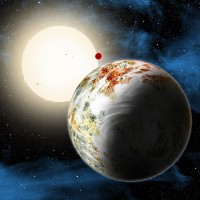'Mega Earth': first strong evidence of massive solid planets

As discussed in Slate's Bad Astronomy blog, a new kind of planet has been found. This “mega Earth” is a rocky planet far more massive than our own.
The discovery was made using the HARPS-North detector and is described in the paper 'The Kepler-10 planetary system revisited by HARPS-N: A hot rocky world and a solid Neptune-mass planet', which was co-authored by Ken Rice, of the School's Institiute for Astronomy.
"It's fascinating that we continue to be surprised by what we discover about the characteristics and properties of exoplanetary systems. It's quite difficult to explain the formation of a massive, solid exoplanet, but it's existence gives us an additional constraint that we will need to apply to theories of planet formation." Dr Ken Rice, Institute for Astronomy
HARPS-North
The HARPS-N spectrograph (High Accuracy Radial velocity Planet Searcher-North) was built at the UK Astronomy Technology Centre in Edinburgh and the Geneva Observatory. It began operation in the Canary Islands in 2012, and is the northern counterpart of HARPS in the Chilean Andes.

